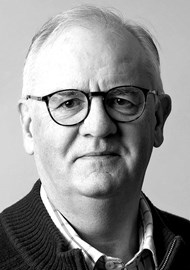Vasant Oswal was, for many years, ‘Mister ENT’ in the Northeast of England. Appointed as a consultant to the old North Riding Infirmary in 1970, he led what was a small and little-known department through a period of tumultuous change so that it is now at the forefront of British otolaryngology with a reputation for excellence in head and neck oncology, cochlear implantation, and the education and training of a new generation of ENT surgeons.
How a boy, born to a lower middle class family in Pune in India in 1934 spearheaded such a remarkable transformation is the subject of this highly engaging autobiography. I was hooked from the start. Mr Oswal recreates a world in pre-independence India where he cycled each morning to a farm for milk, then to another shop for paraffin to power the family cooking stove. There was great excitement when the local cinema showed ‘talkies’ accompanied by a live pianist, and where motor cars and ready-to-wear clothing were unknown. Also unknown of course were antibiotics, and Mr Oswal recounts some poignant tales of how infectious diseases such as typhoid, diphtheria and tuberculosis (consumption) touched his family, sometimes with tragic and fatal consequences.
A stint as a casualty officer in Bombay (now Mumbai), the beating heart of the ‘Bollywood’ film industry, led to a meeting with the celebrated 40s star Mahipal Bhandari, and eventually to marriage to his daughter, the beautiful Nirmal, who in many ways is the star of this book. So, Mr Oswal married into Bollywood royalty, and some of the early sepia photographs of him and Nirmal look very like the old matinee-idol publicity shots of the 40s. What a handsome couple they were - she still beautiful now while he has matured to be a distinguished older gent, but still dashing!
I was fascinated by the way the author weaved his personal story into the historical background, and recounted many seismic events which formed the backdrop to his journey. He really brings alive the pathos and traumas that marked the independence and partition of India in 1947 and scarred a generation. As he described it, millions of Hindus and Muslims found themselves on the ‘wrong side’ of the border, and a mass migration – on foot, on bullock carts, and in trains – commenced, with some two million deaths, and refugee camps rife with hunger and disease. In one of the many historical quirks he references, it transpired that the assassin who shot and killed Mahatma Gandhi – on the day of an Oswal family wedding – was a close relative of the young Vasant’s maths teacher!
The historical backdrops continue throughout. He reminisces about the early days in the NHS, the fractious disputes between doctors and the then secretary of state for health, Barbara Castle, in the 70s, the miners’ strike which so devastated communities in the north-east of England, and the huge technological developments in ENT which occurred during his professional lifetime. Some of the tales of his surgical exploits in emergencies would make the hair stand up on your head, such as the time he had to do a tracheostomy on a woman in the throes of labour and how he had to come to the rescue of children with potentially fatal bleeds post-tonsillectomy in remote settings.
One of his many wonderful legacies is that he introduced laser surgery to Middlesbrough. For many years, the Cleveland Laser Centre was a beacon of excellence in the management of head and neck malignancies – and in the training of a whole generation of ENT doctors, including this reviewer – in what was then an innovative and far-sighted approach to laryngeal cancer. It is fair to say that, to this day, many patients who might otherwise have had mutilating and very extensive surgery, have a far better quality of life due to the less invasive techniques that the laser permitted. So, Mr Oswal’s legacy extends well beyond the north-east, indeed well beyond the UK.
One of the most touching sections of the book is the description of Mr Oswal’s arrival in England. He had little money and a kindly taxi driver helped put him on a bus to Middlesbrough, where he rose to become a distinguished – now emeritus – surgeon, a fellow by election of the Royal College of Surgeons of England, but perhaps more importantly, a much-loved benefactor to the people of the north-east, who clearly love him dearly, and with good reason.
Beautifully illustrated with some original photographs, the book is full of humorous anecdotes, such as the time he arrived in Oporto with no luggage, and had to seek advice from Nirmal re what to do about a change of underwear!
I can only suggest you read the book, it is a treasure trove of wisdom, humour and historical nuggets, but mostly a wonderful tale of a warm-hearted young man from Pune who, as did so many of his compatriots, made a huge contribution to the NHS and to British surgery.





